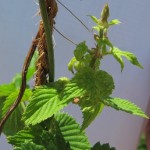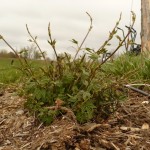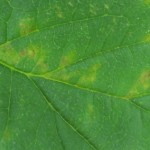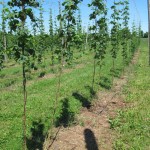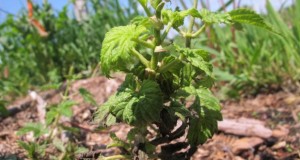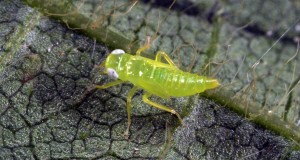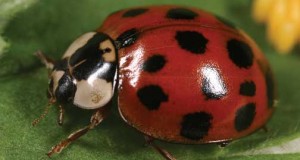By: Rosalie Madden – Crop and Soils Technician & Dr. Heather Darby – UVM Estension Agronomist | University of Vermont Extension – June 2012 | Photos: courtesy of UVM Extension
Downy mildew (Pseudoperonospora humuli, Miyabe and Takah., Wilson) is a significant issue in hops in the Northeast. Both Humulus lupulus and H. japonicas act as a host to P.humuli, as do certain nettles (Uritca spp.) (Johnson et al. 2009). P. humuli is closely related to the downy mildew that you can find on familiar crops such as cucumbers and watermelons, but is not so closely related that the downy mildew from your squashes will infect your hops and vice versa (Johnson et al. 2009). Downy mildew can cause the complete loss of marketable hop yield, and even hill death in sensitive varieties (Johnson et al. 2009). It is a very serious hindrance to successful hops production, but diligent integrated pest management (IPM) can help reduce disease infection, and/or help control downy mildew once the disease has reached your hopyard. The goal of IPM practices is to integrate a multipronged approach that includes prevention, observation, and various intervention strategies to reduce or eliminate the use of pesticides, while at the same time managing pests at an acceptable level. This article will provide some guidelines and strategies on how to control downy mildew in a sustainable manner.
Disease Symptoms
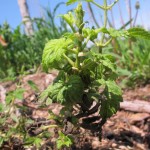
Figure 1. Primary basal spike. Note short internodes, yellowing, down-curled leaves and leaf necrosis at the base.
One of the most critical steps in IPM is proper pest identification. Downy mildew produces characteristic diseased shoots, called “spikes” (Figures 1, 2, 4). Spikes will be stunted with short internodes, and appear chlorotic with yellow-green, down curling or cupping leaves (Johnson et al. 2009).
The leaves will often be brittle, and will dry up starting at the base of the spike. In the right conditions, necrosis will eventually move to the tip of the spike. When these spikes emerge out of the crown, they are called primary basal spikes (Figure 1). On a primary spike you will see symptoms on the shoot tissue from the ground up.
Secondary spikes are diseased shoots that appear from an infected apical meristem. An apical meristem is the growing point on a plant; in the case of hops this can either be a sidearm or the top of the growing plant (Figure 2). With a secondary spike, the plant tissue below the infection remains normal in appearance, and the spike itself will usually become necrotic and desiccated in dry weather. Compared to a primary spike, the internodes may not be as noticeably shortened on a secondary spike. Trained bines that become infected will often be developmentally arrested, and the bines will fall off the string (Figure 3) (Johnson et al. 2009).
Spikes are fairly characteristic of this disease, and once you see it, it is hard to mistake them for anything else. However, be forewarned that frost damage can sometimes cause symptoms similar to downy mildew (chlorosis, and, in new growth, necrosis of the leaves and shoot tips). As a result of a late frost, shoots may be stunted and older leaves may have a rough, silvery appearance (Mahaffee et al. 2009b) (Figure 4). Recent weather patterns should be taken into consideration when evaluating your hopyard early in the spring. Plants will usually recover from frost damage.
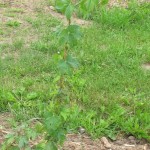
Figure 3. Downy mildew infecting the apical meristem at the top of the plant. Note how bine is falling off the string.
Downy mildew will cause localized leaf lesions to appear on the underside of a leaf. Downy mildew lesions are usually delimited by leaf veins, appearing angular and water soaked (Figure 5). These lesions will become necrotic and light to dark brown. Sporangia (the structure in which spores are produced) may form a mass on the underside of the leaf or spike and appear as a purple-grey or black growth (Johnson et al. 2009).
Inflorescences that become infected are dark brown, shriveled and dried up, and can fall off the plant. Cones become brown and hardened and, with an early infection, will stop developing. Depending on when the infection occurred, the cone can either be completely dark brown, or only have a few discolored bracts, giving a striped or variegated appearance (Johnson et al 2009).
Depending on the cultivar, the appearance of infected crowns can vary. Infected crowns can appear reddish-brown to black, or have streaks in the white crown tissue next to the bark. (Be sure to not confuse the reddish-brown tissue found in the center of healthy crowns that you will find in some cultivars!) Depending on the cultivar, infected crowns can be completely rotted, appear healthy, or anywhere in between (Johnson et al. 2009).
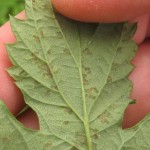
Figure 5. Localized leaf lesions on underside of leaf (bottom). Note how lesions are delimited by leaf veins.
If you would like to confirm that downy mildew has infected your hop plants, you can submit a sample to your local University Extension Plant Diagnostic Laboratory. Visit their website or call them for specifications on how to prepare and submit a sample. A diagnosis will cost between $15 and $30, depending on the lab.
Contact your local Plant Diagnostic Lab by following the links below or contacting your local Extension office.
Cornell University Plant Disease Diagnostic Clinic
334 Plant Science Building
Ithaca, NY 14853
UMass Plant Diagnostic Lab
101 University Drive, Suite A7
Amherst, MA 01002
University of Vermont Plant Diagnostic Clinic
201 Jeffords Building 63 Carrigan Drive
University of Vermont
Burlington, VT 05405
Downy Mildew Lifecycle
Understanding a pest’s lifecycle is important when developing a management plan. In order for a disease outbreak to occur there must be a “disease triangle”, consisting of a susceptible host, a conducive environment, and the pathogen.
Like most mildews, P. humuli will thrive in warm, moist environments. Sporangia are usually produced when the average relative humidity is greater than 71%, and the nightly minimum temperature is greater than 41°F. The number of hours with a relative humidity greater than 80% is the greatest predictor of a downy mildew outbreak. Plant tissue needs to be moist for spores to germinate. For shoot infection to occur, water needs to be sitting for three hours with temperatures ranging from 66° –73°F or for six hours at temperatures of 46°–50°F. Leaf infection doesn’t require as long of a wetness period, and can occur in 1.5–2 hours, optimally at 59°–84°F, but will occur at temperatures as low as 41°F when the leaf is wet for greater than 24 hours. A general rule of thumb is that appreciable leaf and shoot infection will occur if it is wet at moderate temperatures for four to eight hours (Johnson et al. 2009).
Downy mildew can live on infected leaves, shoots, and cones, and will usually overwinter in infected dormant buds and crowns as intercellular mycelium. Mycelium that overwinters in the crown will spread into developing buds during winter and early spring, which is why shoots are already infected when dormancy breaks, resulting in primary basal spikes. However, infected crowns don’t always yield basal spikes; sometimes infected crowns will yield both healthy shoots and infected basal spikes, and sometimes infected crowns will only yield healthy shoots (Johnson et al. 2009).
Sporangia are produced on the underside of leaves at night when the temperature and humidity are favorable. These spores are released in mid-morning to early afternoon, especially in rainy conditions.
Sporangia land and germinate, producing spores that enter the plant through open stomata. The spores can infect leaves, bud stipules, apical meristems, and cones if the conditions are favorable. As discussed, infected leaves will result in localized leaf spots (Figure 5), which produce secondary inoculum to further infect more shoots, leaves, and cones. Leaf lesions usually desiccate quickly in dry weather and don’t last long. Apical meristem infections, however, become systemic, producing secondary spikes and more sporangia. With an apical meristem or a secondary spike infection, the mycelium will progress down the shoot tissue toward the crown during the growing season. If the mycelium reaches the crown, hill death can result, either immediately or over time, depending on the variety. The infected plant will often die as a result of reduced carbohydrate reserves caused by the disease (Johnson et al. 2009).
Strategies for Controlling Downy Mildew
The pathogen can appear in your yard through various means. Spores can be swept in on the wind, brought in on diseased root stock, or through the grower accidently carrying it into his or her field on their clothes after visiting another hop-growing friend. Planting disease-free hop plugs is one way to be certain that you are not bringing disease into your hopyard. The Northeast Hop Alliance has started a program to propagate disease-free stock for members. Various other commercial sources can be found for disease-free stock as well. Scouting for disease should be conducted on a regular basis (weekly) to determine the degree of infection as well as to evaluate if the pathogen is spreading further. In addition, monitoring the weather conditions will help to determine if the environment is right for disease infection. Control options can be both preventative and remediative in nature. A multifaceted approach should be used to have the best success.
Cultural/Mechanical Control
Planting resistant cultivars is the first important step in preventing a serious outbreak of downy mildew (Table 1)*. Cultivars vary in susceptibility to crown rot and to cone, leaf, and shoot infection, but no cultivars are immune. Cascade, Fuggle, Perle, Tettnang, and Willamette all display moderate resistance to downy mildew. Cluster, Galena, Hallertauer Mittelfrüh, Hersbrucker Spält, and Nugget are all susceptible to foliar infection (Johnson et al. 2009). Bullion, Brewer’s Gold, and Cascade are considered by Skotland and Johnson (1983) to be tolerant to crown and foliage infection, while still requiring fungicides to control foliage infection. Crown rot susceptibility varies among cultivars, with Cluster being extremely susceptible, which is the reason that Cluster is usually not grown in high-rainfall areas (Johnson et al. 2009).
Strict sanitation is another important step in reducing the incidence of downy mildew in your yard. Heavily diseased plants should be completely removed early in the season. Primary basal spikes should be eliminated, either mechanically or chemically (Johnson et al. 2009). Spring pruning is usually done in the late winter or early spring. The goal is to remove buds, shoots, and the previous season’s bines. Various levels of aggressiveness are often employed to do this. Pruning removes all shoots prior to training. Crowning removes the top 0.75-2 inches of the crown prior to bud break.
Scratching scratches the soil surface, removing buds from the top 0.75-2 inches (Beatson et al. 2009). Removing the source of primary infection can effectively reduce the severity of the epidemic (Skotland and Johnson 1983). Skotland and Johnson (1983) advise removing basal spikes weekly as it reduces mildew infection by 75%, and enhances the efficacy of spray controls. In Washington, only 9-10% of hills where spikes were removed weekly had spikes at the end of May. Where basal spikes were not removed with the same tenacity, 21-33% of hills displayed signs of infection (Skotland and Johnson 1983). Another option is to prune later in the season, which can reduce the severity of an infection, particularly in areas with shorter growing seasons. However, if pruning is done too late in the season, it will reduce yields (Johnson et al. 2009), and some argue that it may not be overly effective in a damper climate (Skotland and Johnson 1983). Beatson et al. (2009) state that pruning timing is cultivar-specific, as it affects the training timing, which in turn impacts yield. Growers will often hill up around the crown in mid-season as it encourages the development of roots and rhizomes near the top of the crown. This helps to suppress downy mildew in the current season since the diseased shoots next to the crown are buried (Beatson et al. 2009).
After training, bines should be stripped. Stripping removes the superfluous growth of leaves and laterals from the lower five feet of the trained bine (Beatson et al. 2009). Stripping reduces inoculum density, and limits the disease’s spread into the upper canopy (Beatson et al. 2009; Johnson et al. 2009). Stripping also reduces the humidity around the base of the plant by increasing airflow. Stripping can be done either manually or chemically (Beatson et al. 2009). A desiccant spray can be used to simultaneously take out basal spikes and strip, but bines must be trained and at least seven feet tall before a chemical desiccant can be used without hurting the crop, and at this point it is often too late to prevent serious infection (Skotland and Johnson 1983). The date and frequency of stripping can have a significant effect on the carbohydrate reserves in the plant’s root system. When you are stripping, it is important to think of what will happen three months down the road at harvest. When the bine is harvested, there needs to be enough leaf tissue left in the field so that the plant can continue to photosynthesize and accumulate carbohydrates before winter dormancy. The deleterious effects of excessive stripping can be more severe in early-maturing varieties, or plants that are already weakened by soil-borne disease (Beatson et al. 2009).
The success of your sanitation practices depends on your thoroughness, and can help delay an epidemic. Aside from pruning and stripping, there are other practices that are critical to disease management, such as avoiding excessive nitrogen fertilization. Using overhead irrigation should also be avoided, as it increases leaf wetness. In cases with high disease incidence, an early harvest can be a tool to reduce cone infection (Beatson et al. 2009; Johnson et al. 2009).
Chemical Control
When the weather conditions are favorable for downy mildew, spraying preventatively is key (Johnson et al. 2009). Disease prediction models exist for downy mildew and hops in the Pacific Northwest and in Europe. There are currently no disease prediction models for hops in the Northeast, but the Network for Environment and Weather Applications has grape forecasting models in our region for grape downy mildew, which will give you an idea of what to expect. Use your judgment in evaluating weather patterns to determine when inoculum levels might be high. Based on the temperature and weather, it may not be necessary to spray in the early spring if it is cool, below 41°F, or if there is low relative humidity. However, low temperatures don’t prevent sporulation for extended periods. Rainy weather will help liberate the sporangia from spikes (Johnson and Skotland 1985), and it is still very important to keep on top of spike removal.
When using a fungicide, be sure to read the fungicide label in its entirety! It is illegal to use a chemical on a crop or on a pest for which it is not specifically labeled, and it can often do more harm than good. Keep in mind that not all chemicals are legal in every state; be sure to check with your local Extension or Agency of Agriculture. It is also important to remember that while a chemical may be legal and labeled for use in a state there is no assurance that the material is effective against a particular pest on a particular crop, even if it is on the label. Also be sure to adhere to pre-harvest intervals and use proper personal protection equipment. Downy mildew can develop resistance to fungicides fairly rapidly; it is very important to vary the mode of action of the fungicides that you use in your yard (Johnson et al. 2009). Each class should only be used a few times per season, which is usually specified on the label. If the label permits, it can be very beneficial to tank mix fungicides that have a high risk for resistance development with fungicides that have a low risk (Mahaffee et al. 2009a). Be sure to read the label carefully, as some mixtures are phytotoxic to some crops but not others. For example, using both oil and copper products in an apple orchard will result in phytotoxicity, but will work fine with tomatoes. It is always advisable to try out a new fungicide or tank mix on a few plants to evaluate a crop’s reaction before spraying the whole yard. Also note that there are some varietal differences in reactions to certain pesticides. The burr is very susceptible to mechanical damage during pesticide applications, so if at all possible, try to avoid spraying during burr development. Instead spray a product that is a very effective protectant with a long residual just prior to flowering. Basal growth should also be removed just prior to flowering to minimize the spread of disease (Mahaffee et al. 2009a).
See Table 2* for a list of approved fungicides on hops in MA, NY and VT for 2012. This list is not exhaustive; please check with your local Extension or Agency of Agriculture.
References
Beatson, R.A., S.T. Kenny, S.J. Pethybridge, D. H. Gent. 2009. Hop Production. In W. Mahaffee, S. J. Pethybridge, & D. H. Gent (Eds.), Compendium of Hop Diseases and Pests (pp. 5-8). St. Paul, Minnesota: The American Phytopathological Society.
Gent, D., J.D. Barbour, A.J. Dreves, D.G. James, R. Parker, D.B. Walsh, eds. 2009. Field Guide for Integrated Pest Management in Hops. Washington Hop Commission.
Johnson, D.A. & C.B. Skotland (1985). Effects of Temperature and Relative Humidity on Sporangium Production of Pseudoperonospora humuli on Hop. Ecology and Epidemiology, 75 (2), 127-129.
Johnson, D.A., B. Engelhard, and D.H. Gent. 2009. Downy Mildew. In W. Mahaffee, S. J. Pethybridge, & D. H. Gent (Eds.), Compendium of Hop Diseases and Pests (pp. 18-22). St. Paul, Minnesota: The American Phytopathological Society.
Mahaffee, W., B. Engelhard, D.H. Gent, & G.G. Grove. 2009a. Powdery Mildew. In W. Mahaffee, S. J. Pethybridge, & D. H. Gent (Eds.), Compendium of Hop Diseases and Pests (pp. 25-31). St. Paul, Minnesota: The American Phytopathological Society.
Mahaffee, W., S.J. Pethybridge, D.H. Gent. 2009b. Injuries Caused by Environmental Factors. In W. Mahaffee, S. J. Pethybridge, & D. H. Gent (Eds.), Compendium of Hop Diseases and Pests (pp. 73-74). St. Paul, Minnesota: The American Phytopathological Society.
Skotland, C.B. and D.A. Johnson. Control of Downy Mildew of Hops. Plant Disease, 67, 1183-1185.
*Note: Tables 1 and 2 could not be reproduce effectively for this post, thus they have been omitted. The original article, which includes the tables, can be found by clicking here.
 Ontario Hop Growers' Association The OHGA is a not-for-profit association of hop growers, families and enthusiasts who are interested in supporting the growth of the hop industry in Ontario.
Ontario Hop Growers' Association The OHGA is a not-for-profit association of hop growers, families and enthusiasts who are interested in supporting the growth of the hop industry in Ontario.
